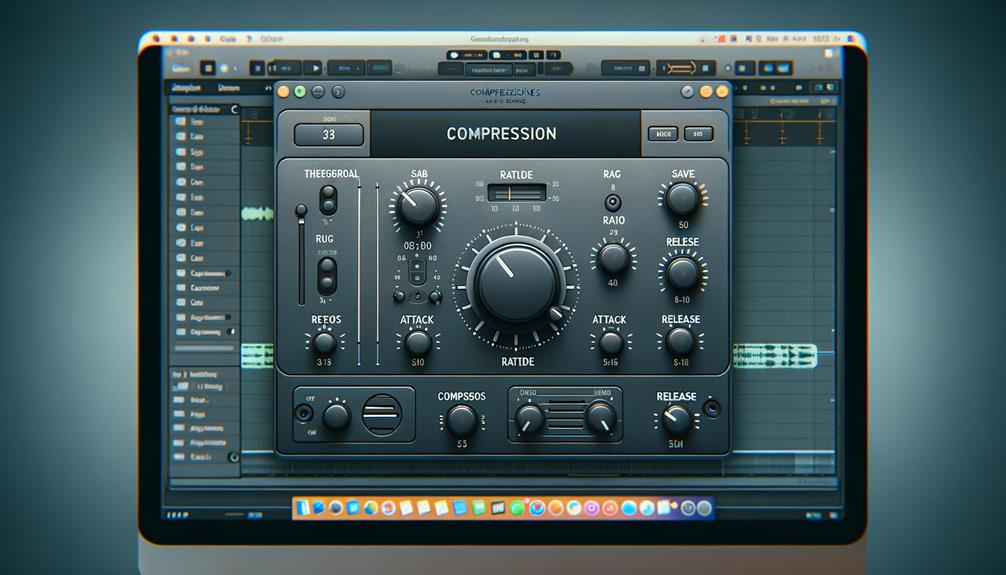No products in the cart.
If you’ve ever struggled with managing the file size of your audio recordings, there’s a solution you might not be aware of.
Compressing audio in Audacity can significantly reduce the file size without compromising the quality of your recordings.
But, just knowing how to import and export audio is not enough.
There’s a specific process to follow and a few key settings to adjust in order to achieve the best results.
So, let’s explore the steps to compress audio in Audacity and uncover the essential techniques for optimizing your audio files.
Contents
hide
Key Takeaways
- Audio compression in Audacity reduces the dynamic range of audio files.
- The compressor effect in Audacity allows for increased amplification without distortion or clipping.
- Key controls for audio compression in Audacity include threshold, ratio, attack time, and release time.
- Adjusting compression settings in Audacity can help achieve the desired compression level and maintain sound quality.
Understanding Audio Compression
To effectively understand audio compression in Audacity, you must grasp the fundamental principles behind the compressor effect and its key controls.
The compressor effect in Audacity is a vital tool for manipulating the dynamic range of audio files. It reduces the dynamic range, allowing for increased amplification without causing distortion or clipping.
Understanding the graph and controls, such as Threshold, Ratio, Attack Time, and Release Time, is essential for effectively applying audio compression in Audacity.
The Threshold control sets the level at which the compressor begins to reduce the audio signal. The Ratio control determines the amount of gain reduction applied once the signal exceeds the threshold.
The Attack Time specifies how quickly the compressor responds to an audio signal that exceeds the threshold, while the Release Time determines how quickly the compressor stops attenuating the signal once it falls below the threshold.
Accessing the Compressor Tool
When accessing the Compressor tool in Audacity, navigate to the ‘Effects’ menu to locate and utilize the tool. Click on the “Effects” menu in Audacity to access the Compressor tool. Once in the Effects menu, scroll down and select “Compressor” from the list of available effects. The Compressor tool allows you to adjust the Threshold, Ratio, Attack Time, and Release Time sliders to customize the compression effect. Experiment with different settings to achieve the desired compression level for your audio. After applying the compressor, preview the audio to assess the impact and make further adjustments if needed.
| Threshold | Ratio | Attack Time |
|---|---|---|
| 0 dB | 2:1 | 10 ms |
| -20 dB | 4:1 | 20 ms |
| -10 dB | 3:1 | 15 ms |
Accessing the Compressor tool in Audacity allows you to fine-tune the audio compression to achieve the perfect balance of dynamics. By adjusting the settings, you can effectively control the audio levels and enhance the overall sound quality of your audio files. This precise tool is a valuable feature for individuals seeking to professionally compress audio within Audacity or any Audio Converter.
Adjusting Compression Settings

Adjust compression settings by carefully adjusting the threshold, ratios, attack and release times, and noise floor to achieve the desired audio compression.
- Understanding the Threshold: The threshold determines the level at which compression begins. Set it lower to compress more of the audio or higher to only compress the loudest parts.
- Ratios and Their Impact: Experiment with different ratio settings to find the right balance between the input level and the output level. A higher ratio results in more compression, while a lower ratio applies less compression.
- Modifying Attack and Release Times: Adjust the attack time to control how quickly the compressor responds to audio levels above the threshold. The release time determines how long it takes for the compressor to stop compressing after the audio falls below the threshold.
- Utilizing Noise Floor: Set the noise floor to prevent the compressor from amplifying background noise. This setting ensures that only audio above a certain level is compressed, maintaining the quality of the recording.
Applying Compression to Audio
You can apply compression to audio by using Audacity’s Compressor effect to reduce the dynamic range and allow for increased amplification without clipping. This process is crucial for maintaining sound quality and ensuring that all parts of the audio are heard clearly.
In Audacity, applying compression is straightforward. Simply select the section of audio you want to compress, navigate to the Effect menu, and choose Compressor. From there, you can adjust the threshold, ratio, attack time, release time, and noise floor to tailor the compression to your specific needs.
By following these simple steps, you can effectively compress audio and enhance its overall clarity and impact. The Compressor in Audacity also provides controls to amplify audio as much as possible after compression, making it especially useful in noisy environments or for making distant voices sound louder.
Exporting Compressed Audio Files


To export compressed audio files in Audacity, follow these steps:
- Navigate to the Effects menu and select the ‘Compressor’ option.
- Choose the audio you want to compress by double-clicking it.
- Access the ‘Compressor’ in the Effects menu.
- Adjust the Threshold to the desired level, such as -20 dB.
- Set the Ratio to the desired compression level, such as 3:1.
When exporting the compressed audio file, consider the file size and the desired audio format. Audacity provides various audio formats for exporting, such as MP3, WAV, and OGG. Selecting the appropriate format can help in preserving the quality of the compressed audio while managing the file size effectively.
To export the file, follow these steps:
- Navigate to the File menu.
- Select Export.
- Choose the desired audio format.
- Specify the export settings.
- Save the compressed audio file to the preferred location on your computer.
Frequently Asked Questions
How Do I Reduce the Size of an Audio File in Audacity?
To reduce the size of an audio file in Audacity, adjust the compression settings like Threshold, Ratio, Attack Time, and Release Time. Utilize Audacity compression techniques for efficient reduction, ensuring the best practices are followed to maintain audio quality.
How Do I Reduce the Size of an Audio File?
To reduce the size of an audio file, you can employ various audio compression techniques, such as bitrate reduction and file size optimization. This involves audio data compression, balancing lossy vs lossless compression for optimal results.
How Do I Shrink a Track in Audacity?
To shrink a track in Audacity, utilize audio compression techniques. Understand Audacity compression settings and bitrate. Follow best practices for shrinking tracks and optimize Audacity file size. These steps will help you effectively reduce track size.
How Do I Reduce Quality in Audacity?
To compress vocals in Audacity, lower the audio bitrate, minimizing distortion and lowering resolution. Shrink the file size by adjusting the compression settings. Experiment with different ratios and thresholds to achieve the desired audio quality.
Conclusion
Now that you have learned how to compress audio in Audacity, you can effectively improve the quality and consistency of your audio files. By understanding audio compression, accessing the compressor tool, adjusting settings, applying compression, and exporting compressed audio files, you can enhance the overall sound of your recordings.
Experiment with different settings and find the best compressor settings that work for your specific audio and personal preference.




